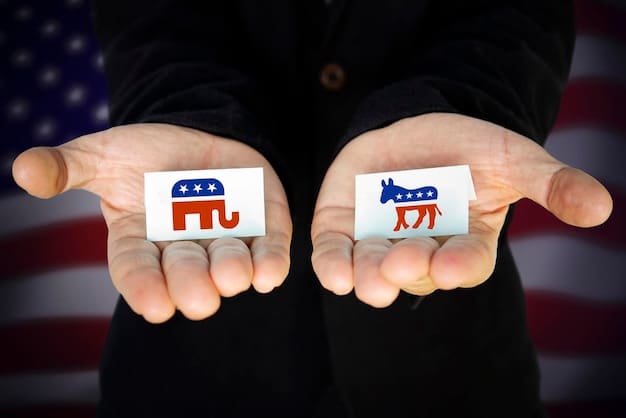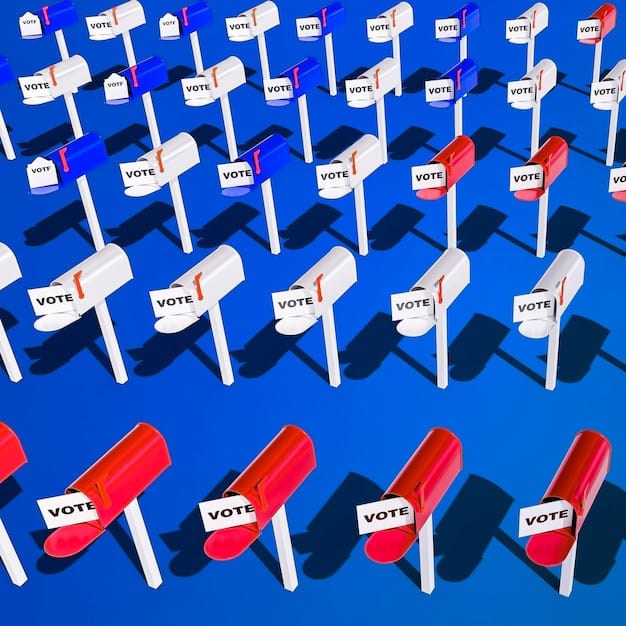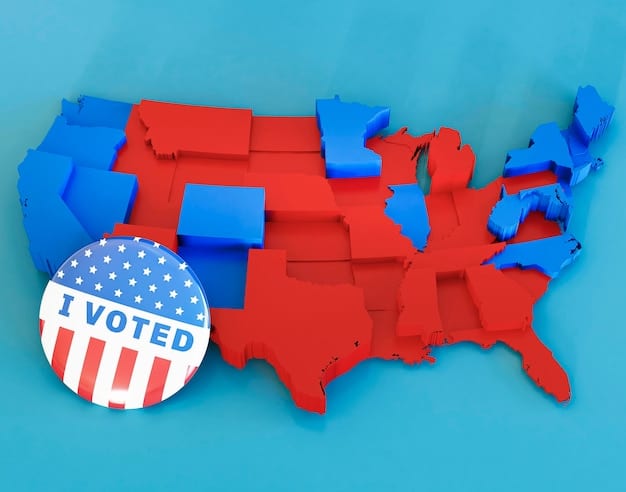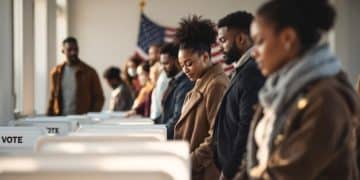Electoral College Changes: Potential Consequences on US Elections

The potential consequences of proposed changes to the Electoral College could significantly alter future presidential elections, potentially affecting the balance of power between states and influencing voter engagement and representation.
Exploring the potential consequences stemming from proposed changes to the Electoral College is crucial for understanding the future of US presidential elections. This analysis examines how these changes might impact the democratic process and the balance of power.
Understanding the Electoral College and Proposed Changes
The Electoral College is a cornerstone of the American presidential election system, yet it remains a subject of ongoing debate and proposed reforms. Before diving into the potential consequences, we must first comprehend the fundamentals of the Electoral College and the nature of the suggested changes.
Established by the Founding Fathers, the Electoral College was designed as a compromise between a popular vote election and a Congressional election of the president. Each state is allocated a number of electors equal to its total number of representatives in Congress (House and Senate). The winner of the popular vote in each state typically receives all of that state’s electoral votes, a system commonly known as “winner-take-all.”

Key Aspects of the Electoral College System
The Electoral College has several defining features that contribute to its unique role in presidential elections:
- State-Based Allocation: Electoral votes are allocated to states based on their population and representation in Congress.
- Winner-Take-All System: In most states, the candidate who wins the popular vote receives all of the state’s electoral votes.
- 270 Electoral Votes Needed to Win: A candidate must secure a majority of electoral votes (currently 270 out of 538) to win the presidency.
Proposed Changes to the Electoral College
Various reforms have been proposed over the years to address perceived issues within the Electoral College. Some of the most prominent include:
- National Popular Vote Interstate Compact: An agreement among states to award their electoral votes to the candidate who wins the national popular vote.
- Proportional Allocation of Electoral Votes: Dividing a state’s electoral votes based on the proportion of the popular vote each candidate receives.
- Congressional District Method: Awarding electoral votes based on the winner of each congressional district within a state, with the remaining two electoral votes going to the statewide winner.
Understanding both the current system and these proposed changes is crucial for evaluating the potential consequences and their impact on future presidential elections.
Potential Impacts on Campaign Strategy and Resource Allocation
Changes to the Electoral College could dramatically reshape campaign strategies and resource allocation during presidential elections. Campaigns would need to adapt to new rules of engagement, potentially shifting their focus from traditional swing states to different areas of the country.
Under the current winner-take-all system, campaigns often concentrate their resources on a handful of swing states where the election is expected to be close. These states become battlegrounds for campaign events, advertising, and voter outreach. However, alternative allocation methods could alter this dynamic, leading to a more nationalized approach to campaigning.
Shifting Campaign Focus
Changes to the Electoral College could lead to:
- Increased National Focus: Campaigns may need to broaden their reach and appeal to voters across the entire country, rather than focusing on specific swing states.
- Resource Redistribution: Campaign resources could be spread more evenly across states, potentially increasing voter engagement in traditionally ignored areas.
- Micro-Targeting: Campaigns might invest more heavily in micro-targeting voters based on demographics and preferences, using data analytics to identify and persuade specific segments of the population.
Impact on Third-Party Candidates
The proposed changes could also impact the viability of third-party candidates:
- Increased Visibility: In a system where every vote truly counts, third-party candidates might gain more traction and visibility.
- Strategic Alliances: Third parties could form strategic alliances with major parties to influence policy outcomes in exchange for electoral support.
- Spoiler Effect: The potential for third-party candidates to act as spoilers, drawing votes away from major candidates, could become more pronounced.

Ultimately, changes to the Electoral College would force campaigns to adapt and innovate in their strategies, resource allocation, and voter outreach efforts to remain competitive.
Impact on Voter Turnout and Engagement
One of the most discussed potential consequences of Electoral College reform is its impact on voter turnout and engagement. The perceived importance of individual votes can influence whether people choose to participate in elections, and changes to the Electoral College could alter this dynamic.
In the current system, voters in states with predictable outcomes may feel their votes are less meaningful, leading to lower turnout rates. Additionally, the focus on swing states can marginalize voters in states with less competitive elections. Reforms aimed at making every vote count more equally could potentially boost voter engagement across the country.
Potential for Increased Turnout
Reforms like the National Popular Vote Interstate Compact or proportional allocation could lead to:
- Enhanced Voter Motivation: Knowing their vote directly contributes to the national popular vote tally could motivate more people to participate.
- Greater Inclusivity: Voters in traditionally ignored states might feel more valued, leading to increased turnout rates.
- Competitive Elections: A more even playing field could lead to more competitive elections in all states, driving up voter engagement.
Risk of Decreased Turnout
However, some argue that certain reforms could have the opposite effect:
- Reduced Significance of State Elections: If the national popular vote becomes the sole determining factor, state-level elections might lose their significance.
- Disenfranchisement Concerns: Some voters might feel disenfranchised if their preferred candidate wins the popular vote but loses the election due to other factors.
- Complexity and Confusion: Complicated allocation methods could confuse voters and discourage participation.
The actual impact on voter turnout and engagement would likely depend on the specific reforms implemented and how they are perceived by voters.
Effects on Political Representation and the Balance of Power
The Electoral College plays a significant role in shaping political representation and the balance of power between states. Proposed changes could alter this dynamic, potentially leading to shifts in political influence and representation.
The current system gives smaller states disproportionate influence in presidential elections due to the allocation of a minimum of three electoral votes, regardless of population. Reforming the Electoral College could reduce this advantage, potentially leading to greater representation for larger, more populous states.
Shifting Political Influence
Changes to the Electoral College could result in:
- Increased Influence for Urban Areas: Reforms that prioritize the national popular vote or proportional allocation could amplify the voices of urban areas, which tend to have higher population densities.
- Reduced Influence for Rural Areas: Smaller, rural states could see their influence diminished as their electoral weight decreases relative to larger states.
- Changes in Party Strategy: Political parties might need to re-evaluate their strategies to appeal to a broader range of voters across different regions.
Concerns about Fair Representation
However, some worry that reforms could lead to:
- Domination by Large States: Concerns that a national popular vote system could lead to larger states dominating presidential elections, potentially marginalizing the concerns of smaller states.
- Erosion of Federalism: Some argue that reforms undermine the principles of federalism by reducing the role of states in the election process.
- Potential for Disputes: A close national popular vote election could lead to increased disputes and challenges, particularly if the outcome is contested.
The ultimate impact on political representation and the balance of power would likely depend on the specific details of the reforms and how they are implemented.
Legal and Constitutional Challenges
Any significant changes to the Electoral College are likely to face legal and constitutional challenges. The Constitution grants states significant authority over the election of presidential electors, and reforms could potentially infringe on these rights.
The National Popular Vote Interstate Compact, for example, has faced legal scrutiny over its constitutionality. Critics argue that it violates the principle of “one person, one vote” and infringes on states’ rights to choose their electors. Similarly, other proposed reforms could face challenges under the Equal Protection Clause or other provisions of the Constitution.
Potential Legal Obstacles
Proposed changes to the Electoral College could face legal challenges based on:
- States’ Rights: Arguments that reforms infringe on states’ rights to control the election of presidential electors.
- Equal Protection Clause: Challenges alleging that reforms violate the Equal Protection Clause by diluting the votes of certain individuals or groups.
- Constitutional Amendments: Some reforms might require a constitutional amendment, which is a difficult and time-consuming process.
Historical Precedents
Legal challenges would likely draw on historical precedents and court rulings related to election law and the balance of power between the federal government and the states.
- Baker v. Carr (1962): This Supreme Court case established the principle of “one person, one vote” in state legislative districts.
- Bush v. Gore (2000): This case involved a dispute over the counting of votes in Florida during the 2000 presidential election.
- Various State Election Laws: State election laws play a crucial role in the administration and regulation of presidential elections.
The legal and constitutional hurdles would need to be carefully considered before implementing any significant changes to the Electoral College.
Public Perception and Political Feasibility
Public perception and political feasibility are critical factors in determining the success of any proposed changes to the Electoral College. Reforms must garner sufficient public support and political momentum to overcome opposition and be enacted into law.
Polling data suggests that public opinion on the Electoral College is divided along partisan lines. Democrats tend to favor reforms that would align the election outcome with the national popular vote, while Republicans are more likely to support the current system. This partisan divide makes it difficult to achieve consensus on comprehensive reform.
Public Support and Awareness
Gauging public support requires:
- Informing the Public: Educating voters about the Electoral College and the potential consequences of reforms.
- Addressing Concerns: Addressing concerns about fairness, representation, and the potential for unintended consequences.
- Building Coalitions: Building broad-based coalitions across party lines to advocate for specific reforms.
Political Challenges
Overcoming political obstacles requires:
- Bipartisan Support: Securing bipartisan support in Congress and state legislatures.
- Negotiation and Compromise: Willingness to negotiate and compromise on specific reform proposals.
- Political Timing: Recognizing the political climate and timing efforts to coincide with periods of reform momentum.
Ultimately, the fate of proposed changes to the Electoral College will depend on a combination of public support, political will, and strategic advocacy.
The Role of Technology and Data Analytics
Technology and data analytics are increasingly playing a significant role in presidential elections, and proposed changes to the Electoral College could amplify this trend. Campaigns are using sophisticated tools to target voters, mobilize support, and analyze election data.
With access to vast amounts of voter data, campaigns can micro-target individual voters with personalized messages and tailored appeals. This allows them to optimize their outreach efforts and maximize their impact on election outcomes. Changes to the Electoral College could incentivize campaigns to invest even more heavily in data analytics and technology to gain a competitive edge.
Enhancing Targeting Capabilities
Technology enables campaigns to:
- Identify Key Voters: Use data analytics to identify voters who are likely to be persuadable or highly motivated to vote.
- Personalize Messaging: Tailor messaging to resonate with individual voters based on their demographics, preferences, and past voting behavior.
- Optimize Resource Allocation: Use data to allocate campaign resources more efficiently and effectively.
Potential Risks and Concerns
However, this reliance on technology and data also raises concerns:
- Privacy Concerns: Concerns about the privacy and security of voter data.
- Misinformation and Manipulation: The potential for campaigns to spread misinformation or manipulate voters through targeted advertising.
- Digital Divide: Concerns that technology-driven campaigns could exacerbate the digital divide, leaving some voters behind.
Navigating these challenges will be crucial as technology continues to reshape the landscape of presidential elections.
| Key Points | Brief Description |
|---|---|
| 🗳️ Campaign Strategy | Changes could shift focus from swing states to a national approach. |
| 🙋 Voter Turnout | Reforms might increase engagement by making every vote count more. |
| ⚖️ Balance of Power | Influence could shift between urban and rural areas, large vs. small states. |
| 🏛️ Legal Challenges | Reforms may face scrutiny over states’ rights and constitutionality. |
Frequently Asked Questions
▼
The National Popular Vote Interstate Compact is an agreement among states to award their electoral votes to the candidate who wins the national popular vote, ensuring the presidency goes to the candidate with the most votes nationwide.
▼
Proportional allocation of electoral votes could lead to closer elections and incentivize candidates to campaign more broadly, as every vote within a state would directly contribute to their electoral vote total.
▼
Main concerns include potential disenfranchisement of smaller states, legal challenges based on states’ rights, and the risk of increased political instability due to contested election outcomes.
▼
Technology allows campaigns to micro-target voters, personalize messaging, and optimize resource allocation through data analytics, enhancing their ability to persuade and mobilize specific segments of the population.
▼
The “winner-take-all” system is where the candidate who wins the popular vote in a state receives all of that state’s electoral votes, regardless of the margin of victory, which is used in most states.
Conclusion
The potential consequences of proposed changes to the Electoral College are far-reaching and complex, impacting campaign strategies, voter turnout, political representation, legal considerations, public perception, and the role of technology. Any reform of this foundational system must be approached with careful consideration of its potential effects on the democratic process and the balance of power in the United States.





